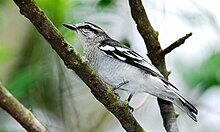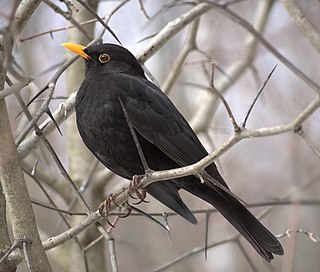
True thrushes are medium-sized mostly insectivorous or omnivorous birds in the genus Turdus of the wider thrush family, Turdidae. The genus name Turdus is Latin for "thrush". The term "thrush" is used for many other birds of the family Turdidae as well as for a number of species belonging to several other families.
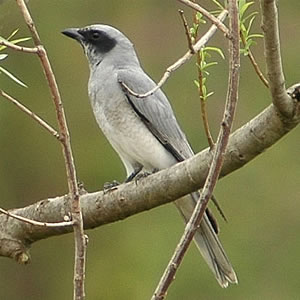
The cuckooshrikes and allies in the family Campephagidae are small to medium-sized passerine bird species found in the subtropical and tropical Africa, Asia and Australasia. The 93 species are divided into 11 genera. The woodshrikes (Tephrodornis) were often considered to be in this family but are now placed in their own family, Vangidae, along with the philentomas and the flycatcher-shrikes. Another genus, Chlamydochaera, which has one species, the black-breasted fruithunter, was often placed in this family but has now been shown to be a thrush (Turdidae).
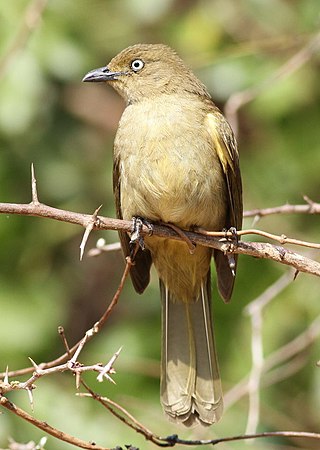
The sombre greenbul is a member of the bulbul family of passerine birds. It is a resident breeder in coastal bush, evergreen forest and dry shrub land in eastern and southern Africa. It is the only member of the genus Andropadus.

The white-shouldered triller is a passerine bird belonging to the triller genus Lalage in the cuckoo-shrike family Campephagidae. It is found in Indonesia and East Timor. The white-winged triller of Australia and New Guinea was formerly included in this species but is now treated as a separate species.

Hypsipetes is a genus of bulbuls, songbirds in the family Pycnonotidae. Most of its species occur in tropical forests around the Indian Ocean. But while the genus is quite diverse in the Madagascar region at the western end of its range it does not reach the African mainland.
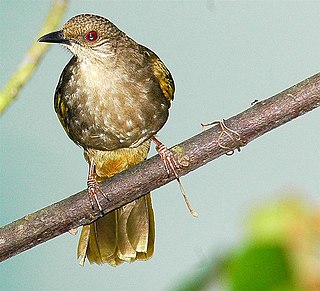
Pycnonotus is a genus of frugivorous passerine birds in the bulbul family Pycnonotidae.

The Polynesian triller is a passerine bird belonging to the triller genus Lalage in the cuckoo-shrike family Campephagidae. It has numerous subspecies distributed across the islands of the south-west Pacific.

The trillers are a group of passerine birds belonging to the cuckooshrike family Campephagidae partially making up the genus Lalage. Their name come from the loud trilling calls of the males. There are about 12 species that usually exist in southern Asia and Australasia with a number of species in Pacific islands. They feed mainly on insects and fruit. They build a neat cup-shaped nest high in trees.

A shrikethrush, also spelled shrike-thrush, is any one of eleven species of songbird that is a member of the genus Colluricincla. They have nondescript, predominantly brown or grey, plumage, but are accomplished singers, their calls described as "strong, mellow and beautiful." Shrikethrushes are generally insectivorous, though have been recorded eating molluscs and berries. They build cup-shaped nests in the forks of trees.
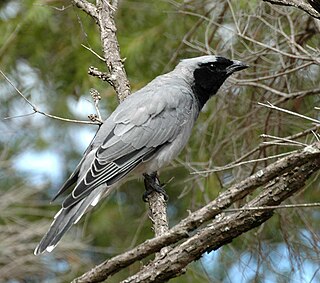
Coracina is a large genus of birds in the cuckooshrike family Campephagidae.

The long-tailed triller is a species of bird in the family Campephagidae. It is found in New Caledonia, Solomon Islands, and Vanuatu. The Norfolk Island subspecies of the long-tailed triller, the Norfolk triller, has become extinct. Its natural habitats are subtropical or tropical moist lowland forests and subtropical or tropical moist montane forests.

The black-and-white triller is a species of bird in the family Campephagidae. It is endemic to the Philippines. Its natural habitat is tropical moist lowland forests.

The pied triller is a species of bird in the cuckooshrike family Campephagidae. It is found in Brunei, India, Indonesia, Malaysia, the Philippines, Singapore, and Thailand.

The Samoan triller, known in Samoan as miti tae, is a species of bird in the family Campephagidae. It is endemic to Samoa. Its natural habitats are subtropical or tropical moist lowland forest and plantations. It is threatened by habitat loss.

Myiagra is a genus of passerine birds in the family Monarchidae, the monarch flycatchers, native to Australasia, sometimes referred to as the broad-billed flycatchers or simply broadbills.

The bristlebills are a genus Bleda of passerine birds in the bulbul family Pycnonotidae. They are found in the forest understorey of western and central Africa. They forage for insects at or near ground-level, often near water. They will follow driver ant swarms to catch prey items fleeing from the ants and they frequently join mixed-species feeding flocks.

The Norfolk triller was a small passerine bird in the cuckooshrike family, Campephagidae. It is the extinct nominate subspecies of the long-tailed triller which was endemic to Norfolk Island, an Australian territory in the Tasman Sea between Australia and New Zealand. Little is known of its biology.

The black-browed mountain greenbul, formerly the black-browed greenbul, is a species of the bulbul family of passerine birds. It is found in south-eastern Africa from south-western Tanzania to north-eastern Zambia, Malawi and west-central Mozambique.

Edolisoma is a genus of birds in the cuckooshrike family Campephagidae that are native to the Central Indo-Pacific region, Australia and New Guinea.

Ceblepyris is a genus of African passerine birds in the cuckooshrike family Campephagidae.
